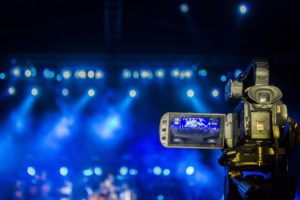A Video Of Your Speaking Presentation Can Enhance Your Worth
What to Know Before Hiring a Videographer:
Most of us are aware that a good speaker video is a must-have for marketing yourself as a speaker. Meeting planners evaluate your speaking style, your content, and how you effectively connect with an audience. One of the most frequently asked questions I get from my emerging speaker clients is how to hire a videographer when they have been asked to speak at an event. I recently hired a videographer, Carol Thomson of FireStream Media to film me at a recent conference where I was invited to speak. I interviewed Carol at the end of our video engagement to get her thoughts and insights for the best results in creating a video for a speaking presentation.
1. Know your objective for shooting the video. What do you want as a result of this video? There are several different styles of video: promotional video, educational video, or marketing video. What kind of image do you want to portray? Corporate professional? Informal and fun? Your speech topic(s) will often dictate the feel you want your video to convey. Research and find examples of speakers videos that you like and don’t like so that you can provide examples of what you are looking for to your videographer. It’s important to have a conversation with your videographer early in the process to clarify what you want the end result to look like.
 2. How many cameras? Ask your videographer if they can do a 2-camera shoot. You may have an option of a 3-camera shoot. At a minimum, a 2-camera shoot is advantageous as it allows more variety in your final video. More cameras will add to the cost, but it will result in a higher-quality video.
2. How many cameras? Ask your videographer if they can do a 2-camera shoot. You may have an option of a 3-camera shoot. At a minimum, a 2-camera shoot is advantageous as it allows more variety in your final video. More cameras will add to the cost, but it will result in a higher-quality video.
3. How long? Determine the length of time of your video. Generally speaking, 3 – 4 minutes is a good length for a speaker video. If you have footage from a previous speaking presentation, you can request that footage be added so that you can show variety in your speaking venues.
4. Raw footage. Ask for raw footage up front from your videographer. This can be negotiated in most instances. There may be additional charges for the raw footage, however, the raw footage will allow you to use video clips to create a montage for future speaker reels. Always ask for raw footage without background music – this will make the editing process much easier for your videographer.
5. Staged or live event? A speaking presentation where you are videographed can be either live or staged. There are advantages and disadvantages for both. If you choose to hire a videographer at a live event, always get permission from the meeting planner. Most meeting planners will allow you to bring in a videographer, as long as you can ensure them that the videographer will not detract from the audience’s experience. During a live event, there will be limitations with regards to camera placement. For instance, videographers may not be able to get close-in shots of the speaker due to blocking audience members’ view, or the lighting on stage may pose a challenge. If audience members are going to be filmed, you may need to get permission. Some events have registrants sign a waiver as part of the registration process so that audience members give blanket permission for photography or videography. There may be special seating areas assigned for those who do not want to be photographed or videographed.
For a staged speaking presentation, you may not have many people in your “audience”. However, there are advantages such as camera placement, lighting, and you may get several “takes” if you mess up during your presentation. Often, staged videography will cost you more.
6. Scouting. If you are filming at a location that is unfamiliar to both you and your videographer, scout the location a day or two before the event. Many videographers will offer this as part of their package to you. Do bring this up if your videographer does not during your initial conversation with them.
7. Slides, or not? Discuss whether you want the videographer to include your slides as part of your speaker video. This can add variety when it comes to video editing. Testimonial cards can also be used to add variety and to serve as a transition if you are creating a montage of speaking clips in your video.
The bottom line is a speaker reel is part of your marketing package as a speaker, so do your homework and know what you want as the final outcome. Interview several videographers to ensure there is a good fit, and most importantly, have fun with the process!
